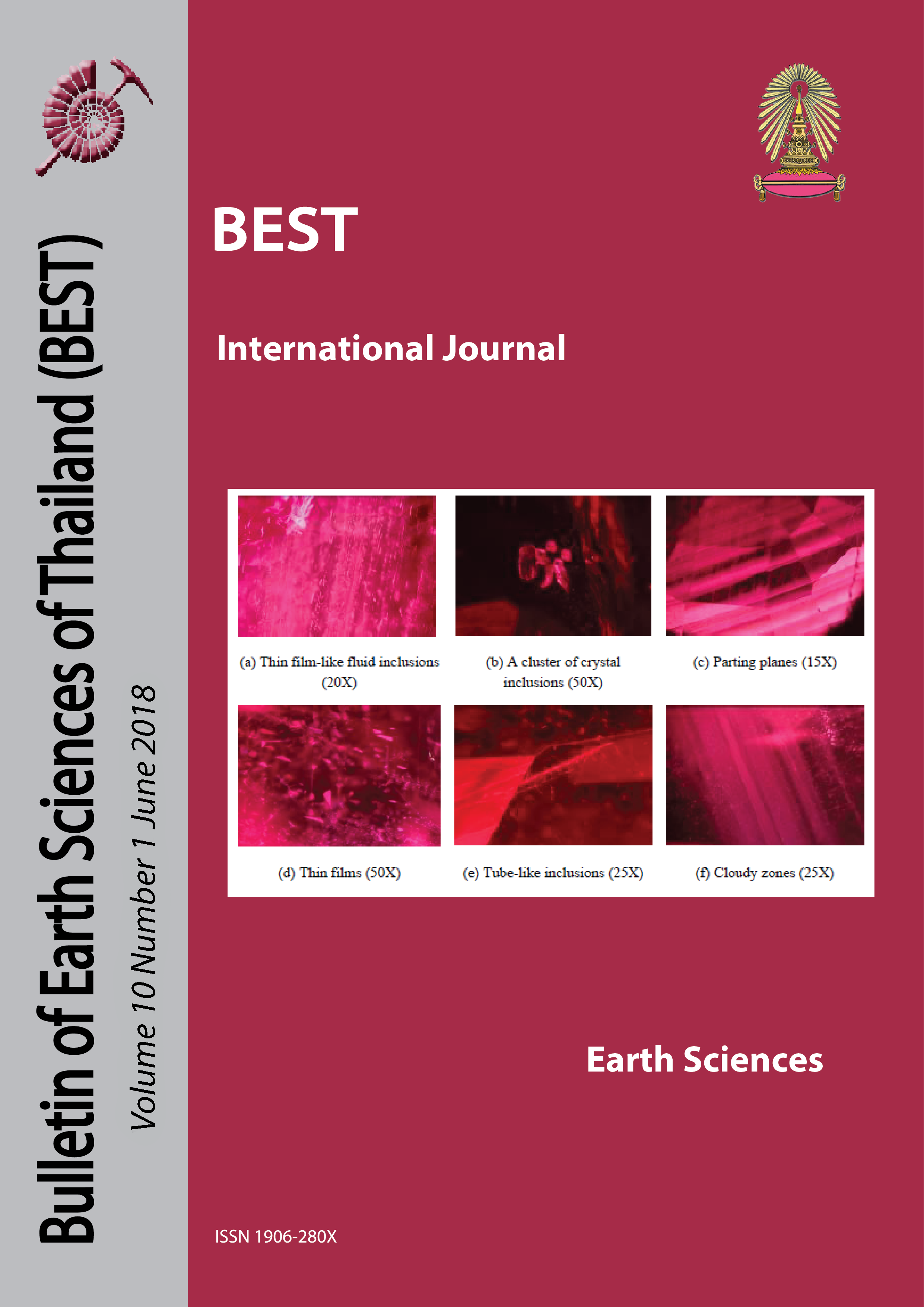Structure of Phu Phan Range in the Khorat Plateau: Its Apatite Fission Track Ages and Geological Syntheses
Main Article Content
Abstract
Phu Phan area in northeastern Thailand has been selected for apatite fission track (AFT) geochronological analyses. Geological transects have been made over the region. Non-marine Mesozoic continental sediments only 4 formations have been encountered in the study area. Structurally, the rocks have been deformed and series of anticlinal structures have been encountered with their fold axes mostly trend in the northwest – southeast direction. The major fold has been displaced by a few of short left-lateral strike slip faults whose trend is in the northeast – southwest direction. Samples of the Khorat Group rocks were identified and collected for AFT analyses. The AFT result along with those of the previous studies reveals an interesting scenario. Three age ranges have been recognized viz., 78 to 60 Ma, 55 to 42 Ma, and about 37 Ma, the oldest range is a very mild event. The first episode corresponds to the movement along the northeast – southwest strike slip fault which may have been in turn caused a compressive stress within the Khorat. Two successive basins within the Khorat region may have been developed. The second episode indicates an extensive exhumation (uplift and erosion) which perhaps took place for the whole Khorat region, becoming a Khorat Plateau. The final episode is marked by the minor movement along the strike slip fault which slightly displaced the main structure of the Phu Phan area. The AFT results from this current and previous studies advocate an average exhumation rate of the Phu Phan Mountain range to be ca. 0.0139 mm/yr.
Article Details

This work is licensed under a Creative Commons Attribution-NonCommercial-NoDerivatives 4.0 International License.
Copyright © 2008 Department of Geology, Faculty of Science, Chulalongkorn University. Parts of an article can be photocopied or reproduced without prior written permission from the author(s), but due acknowledgments should be stated or cited accordingly.
References
Carter, A., Bristow, C. S., & Hurford, A. J. (1995). The application of fission track analysis to the dating of barren sequences: examples from red beds in Scotland and Thailand. Geological Society, London, Special Publications, 89(1), 57-68.
Department of Mineral Resources. (2007). Geological Map of Thailand 1:250,000, Department of Mineral Resources, Ministry of Natural Resources and Environment, Bangkok, Thailand.
Department of Mineral Resources, 2014, Geology of Thailand: Department of Mineral Resources, Ministry of Natural Resources and Environment, Bangkok, Thailand, 508 p. Donelick, R.A., O’Sullivan, P.B., and Ketcham, R.A. 2005. Apatite fission-track analysis. Reviews in Mineralogy and Geochemistry. 58: 49-94.
Galbraith, R. 1981. On statistical models for fission track counts. Journal of the International Association for Mathematical Geology, 13(6), 471-478.
Galbraith, R. F. 2005. Statistics for fission track analysis. CRC Press.
Gleadow, A., Duddy, I., Green, P. F., & Lovering, J. 1986. Confined fission track lengths in apatite: a diagnostic tool for thermal history analysis. Contributions to Mineralogy and Petrology, 94(4), 405-415.
Green, P. 1985. Comparison of zeta calibration baselines for fission-track dating of apatite, zircon and sphene. Chemical Geology: Isotope Geoscience Section, 58(1-2), 1-22.
Hasebe, N., Barbarand, J., Jarvis, K., Carter, A., and Hurford, A.J. 2004. Apatite fission-track chronometry using laser ablation ICP-MS. Chemical Geology, 207: 135-14
Pettijohn, F.J. 1975. Sedimentary Rocks. 2nd Edition. New York: Harper and Row Publishers.
Racey, A. 2009. Mesozoic red bed sequences from SE Asia and the significance of the Khorat Group of NE Thailand. Geological Society, London, Special Publications, 315: 41-67.
Racey, A., Duddy, L., and Love, M. 1997. Apatite fission track analysis of Mesozoic red beds. in Proceeding of the International Conference on Stratigraphy and Tectonic Evolution of Southeast Asia and the South Pacific. Bangkok, Thailand, p. 200-209
Tagami, T., Lal, N., Sorkhabi, B.R., Ito, H., and Nishimura, S. 1988. Fission Track Dating Using External Detector Method: A Laboratory Procedure. Memoirs of the Faculty of Science Kyoto University, 53: 14–30.
Upton, D. R. 1999. A regional fission track study of Thailand: implications for thermal history and denudation. Unpublished Ph.D. Thesis, Birkbeck (University of London).
Veeravinantanakul, A. 2018. Apatite Fission Track Dating of Mesozoic Siliciclastic Rocks from Khorat Group in Phu Phan Mountain Range, Northeastern Thailand. Unpublished M.Sc. Thesis, The Department of Geology, Faculty of Science, Chulalongkorn University.
Vermeesch, P. 2018. IsoplotR: a free and open toolbox for geochronology. Geoscience Frontiers, (in press).
Yates, F. 1934. Contingency tables involving small numbers and the 2 test. Supplement to the Journal of the Royal Statistical Society, 1: 217-235.


